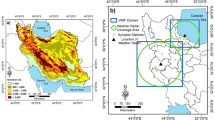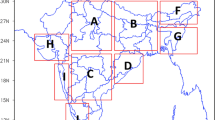Abstract
This paper examines the connection between the probability of precipitation and forecast amounts from Weather Research and Forecasting (WRF) model runs over Central and West Africa. A one season period (June–September 2010) was used to investigate the quantitative precipitation forecast–probability relationship. The predictive capability of this relationship was then tested on an independent sample of data (June–September 2011); 2010 and 2011 were wet and dry years, respectively. The results show that rainfall is less likely to occur in those areas where the model indicates no precipitation than it is elsewhere in the domain. Rainfall is more likely to occur in those regions where precipitation is predicted, especially where the predicted precipitation amounts are largest. The probabilities of rainfall forecasts based on this relationship are found to possess skill as measured by relative operating characteristic curves, reliability diagrams, and Brier skill scores. Skillful forecasts from the technique exist throughout 24-h periods for which WRF output was available. The results suggest that this forecasting tool might assist forecasters throughout the season in a wide variety of weather events and not only in areas of difficult-to-forecast convective systems.







Similar content being viewed by others
References
Accadia C, Mariani S, Casaioli M, Lavagnini A, Speranza A (2005) Verification of precipitation forecasts from two limited-area models over Italy and comparison with ECMWF forecasts using a resampling technique. Weather Forecast 20:276–300
Arkin PA, Meisner BN (1987) The relationship between large-scale convective rainfall and cold cloud over the Western Hemisphere during 1982–84. Mon Weather Rev 115:51–74
Brier GW (1950) Verification of forecasts expressed in terms of probabilities. Mon Weather Rev 78:1–3
Buizza R, Hollingsworth A, Lalaurette F, Ghelli A (1999) Probabilistic predictions of precipitation using the ECMWF ensemble prediction system. Weather Forecast 14:168–189
Buzzi A, Davolio S, Isidoro M, Malguzzi P (2004) The impact of resolution and of map reanalysis on the simulations of heavy precipitation during map cases. Meteorol Z 13:91–97
Dezfuli AK (2011) Spatio-temporal variability of seasonal rainfall in western equatorial Africa. Theor Appl Climatol 104:57–69
Gallus WA Jr, Segal M (2004) Does increased predicted warm season rainfall indicate enhanced likelihood of rain occurrence?Weather Forecast 19:1127–1135
Gallus WA Jr, Baldwin ME, Kimberly LE (2006) Evaluation of probabilistic precipitation forecast determined from Eta and AVN forecasted amounts. Weather Forecast 22:207–215
Gong X, Richman MB (1995) On the application of cluster analysis to growing season precipitation data in north America East of the Rockies. J Climate 8:897–931
Hamill TM, Colucci SJ (1997) Verification of Eta–RSM short-range ensemble forecasts. Mon Weather Rev 125:1312–1327
Hong SY, Pan HL, Lim JOJ (2006) The WRF single-moment 6-class microphysics scheme (WSM6). J Korean Meteor Soc 42:129–151
Houze R, Medina S (2005) Turbulence as a mechanism for orographic precipitation enhancement. Quart J Roy Meteor Soc 62:3599–3623
Huffman G, Adler R, Arkin P, Chang A, Ferraro R, Gruber A, Janowiak J, McNab A, Rudolf B, Schneider U (1997) The global precipitation climatology project (GPCP) combined precipitation dataset. Bull Am Meteorol Soc 78:5–20
Huffman GJ, Morrissey M, Bolvin D, Curtis S, Joyce R, McGavock B, Susskind J, Adler RF (2001) Global precipitation at one-degree daily resolution from multisatellite observations. J Hydrometeorol 2:36–50
Mahoney K, Lackmann G (2007) The effect of upstream convection on downstream precipitation. Weather Forecast 22:255–277
Martius O, Zenklusen E, Schwierz C, Davies HC (2006) Episodes of Alpine heavy precipitation with an overlying elongated stratospheric intrusion: a climatology. Int J Climatol 26:1149–1164
Mason I (1979) On reducing probability forecasts to yes/no forecasts. Mon Weather Rev 107:207–211
Mason I (1982) A model for assessment of weather forecasts. Aust Meteor Mag 30:291–303
Mason SJ, Graham NE (1999) Conditional probabilities, relative operating characteristics, and relative operating levels. Weather Forecast 14:713–725
Mlawer EJ, Taubman SJ, Brown PD, Iacono MJ, Clough SA (1997) Radiative transfer for inhomogeneous atmosphere: RRTM, a validated correlated-k model for the longwave. J Geophys Res 102(D14):16663–16682
Mohanthy UCAR, Krishna KOS, Kiran P (2011) A study on simulation of heavy rainfall events over indian region with ARW-3DVAR modeling system. Pure Appl Geophys 169:381–399
Mullen SL, Buizza R (2001) Quantitative precipitation forecasts over the united states by the ECMWF ensemble prediction system. Mon Weather Rev 129:638–663
Murphy AH (1973) A new vector partition of the probability score. J Appl Meteor 10:155–156
Nicholson SE, Some B, McCollum J, Nelkin E, Klotter D, Berte Y, Diallo BM, Gaye I, Kpabeba G, Ndiaye O, Noukpozounkou JN, Tanu MM, Thiam A, Toure AA, Traore AK (2003) Validation of TRMM and other rainfall estimates with a high-density gauge dataset for West Africa. Part II: validation of TRMM rainfall products. J Appl Meteor 42:1355–1368
Nordeng TE (1994) Extended versions of the convective parameterization scheme at ECMWF and their impact on the mean and transient activity of the model in the tropics. ECMWF Tech Memorandum 206:41
Peterson WW, Birdsall TG, Fox WC (1954) The theory of signal detectability. Trans IRE prof Group Inf Weather Forecast Theory, PGIT, 2–4, pp 171–212
Pujol O, Georgis J, Chong M, Roux F (2005) Dynamics and microphysics of orographic precipitation during MAP IOP3. Quart J Roy Meteor Soc 131:2795–2819
Rao AR, Srinivas VV (2006) Regionalization of watersheds by hybrid-cluster analysis. J Hydrol 318:37–56
Rotunno R, Houze R (2007) Lessons on orographic precipitation from the Mesoscale Alpine Programme. Quart J Roy Meteor Soc 133:811–830
Skamarock WC, Klemp JB, Dudhia J, Gill DO, Barker DM, Wang W, Powers JG (2008) A description of the advanced research WRF version 3. NCAR Tech Note 4751STR , pp 113
Tanessong RS, Vondou DA, Igri PM, Kamga FM (2012) Evaluation of eta weather forecast model over Central Africa. Atmos Clim Sci 2:532–537
Tiedtke M (1989) A comprehensive mass flux scheme for cumulus parameterization in large-scale models. Mon Weather Rev 117:1779–1800
Unal Y, Kindap T, Karaca M (2003) Redefining the climate zones of Turkey using cluster analysis. Int J Climatol 23:1045–1055
Vondou DA (2012) Spatio-temporal variability of seasonal rainfall in western equatorial Africa. Atmos 3:377–399
Wilks DS (1989) Probabilistic quantitative precipitation forecasts derived from PoPs and conditional precipitation amount climatologies. Mon Weather Rev 118:874–882
Wilks DS (1995) Statistical methods in the atmospheric sciences. Cambridge University Press, Cambridge, pp 547
Wilks DS (2001) A skill score based on economic value for probability forecasts. Meteorol Appl 8:209–219
Wilks DS (2006) Statistical methods in the atmospheric sciences. Academic, San Diego
WMO (2000) Standardized verification system (SVS) for long-range forecasts (LRF). World Meteorological Organization, Geneva
Yepdo DZ, Monkam D, Lenouo A (2009) Spatial variability of rainfall regions in West Africa during the 20th century. Atmos Sci Let 10:9–13
Zangl G (2007) To what extent does increased model resolution improve simulated precipitation fields? A case study of two north-Alpine heavy-rainfall events. Meteorol Z 16:571–580
Acknowledgments
WRF simulations were done on a workstation provided by Dr Serge Janicot of LOCEAN (Paris), in the framework of the PICREVAT project, funded by the French government. WRF was provided by the University Corporation for Atmospheric Research website (for more information see http://www.mmm.ucar.edu/wrf/users/download/get_source.html). GPCP data were obtained from the NOAA website http://www.esrl.noaa.gov. TRMM data wereprovided online by NASA at http://mirador.gsfc.nasa.gov.
Author information
Authors and Affiliations
Corresponding author
Rights and permissions
About this article
Cite this article
Tanessong, R.S., Igri, P.M., Vondou, D.A. et al. Evaluation of probabilistic precipitation forecast determined from WRF forecasted amounts. Theor Appl Climatol 116, 649–659 (2014). https://doi.org/10.1007/s00704-013-0965-2
Received:
Accepted:
Published:
Issue Date:
DOI: https://doi.org/10.1007/s00704-013-0965-2




